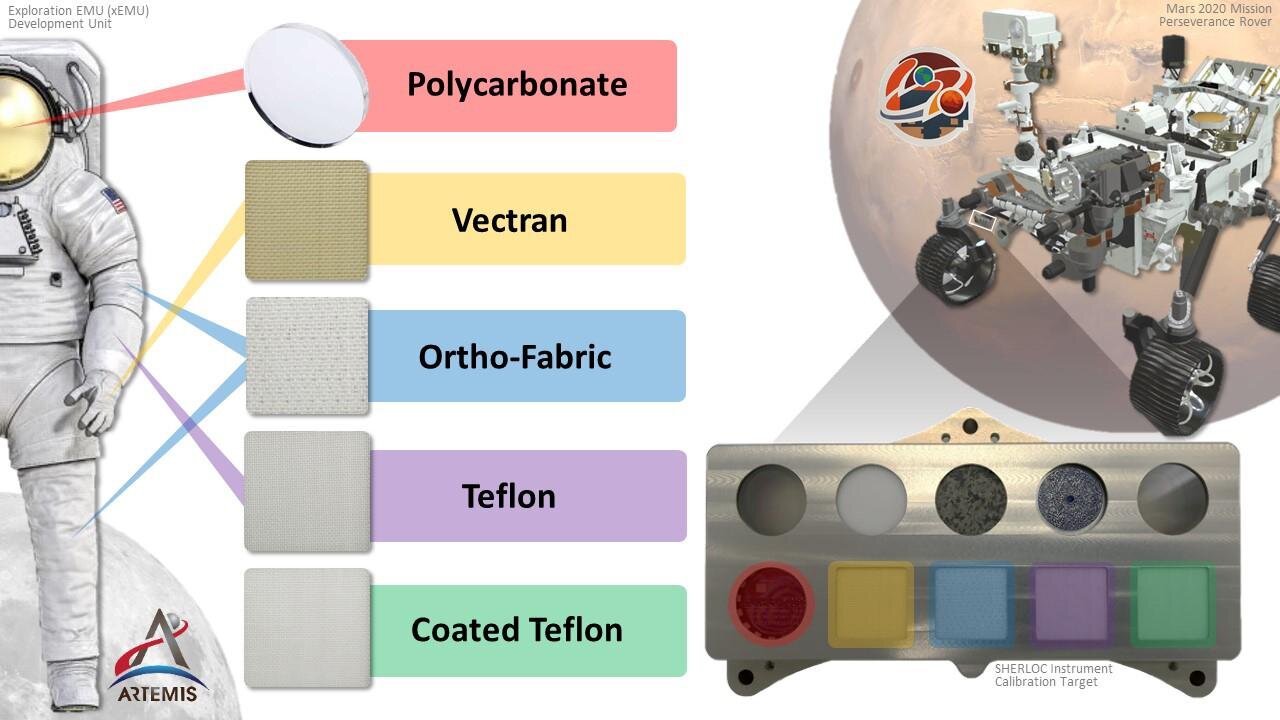The Perseverance rover isn’t just driving around the surface of the Red Planet, studying rock samples. Its research will help better understand what astronauts can expect if they decide to make the trip there.

Predicting the service life of a Martian spacesuit
NASA’s Perseverance rover will land on Mars in 2021 to find signs of ancient microbial life and help scientists understand the planet’s climate and geography. But another key goal is to pave the way for human exploration of Mars, and as part of that effort, the rover is carrying a set of five samples of spacesuit materials. Now after these samples have survived four years on the dusty, radiation-soaked surface of Mars, scientists are beginning the next phase of their study.
The ultimate goal is to accurately predict the life span of a Martian spacesuit. What the agency learns about how materials behave on Mars will inform the design of future spacesuits for the first astronauts on the Red Planet.
Samples aboard the Perseverance
Samples each measuring three-quarters of an inch (20 mm²) are part of a calibration target used to verify the settings of SHERLOC (Scanning Habitable Environments with Raman & Luminescence for Organics and Chemicals), the tool at the end of Perseverance’s arm.
The samples include a piece of polycarbonate helmet visor; vectran, a cut-resistant material used for the palms of astronauts’ gloves; two types of Teflon, which has dust-removing nonstick properties; and a widely used material for spacesuits called Ortho-Fabric. This last fabric has several layers including Nomex, a flame retardant material used in firefighter suits; Gore-Tex, which is waterproof but breathable; and Kevlar, a durable material used in bulletproof vests that makes spacesuits more resistant to tearing.
Martian clothes
Mars is far from welcoming. It’s got sub-zero temperatures, fine dust that can stick to solar panels and spacesuits (causing wear and tear), and a surface teeming with perchlorates, a type of corrosive salt toxic to humans.
Besides, there’s a lot of solar radiation. Unlike Earth, which has a magnetic field that deflects most of the sun’s radiation, Mars lost its magnetic field billions of years ago, and with it most of its atmosphere. Its surface has little protection from the sun’s ultraviolet light (which is why researchers are studying how rock formations and caves can provide astronauts with some protection).
From 2018 to 2021, materials scientist Razzell Hollis was a postdoctoral fellow at NASA’s Jet Propulsion Laboratory in Southern California, where he helped prepare SHERLOC for its arrival on Mars and participated in science operations after the rover landed. He has previously studied the chemical effects of sunlight on a new kind of solar panel made of plastic, as well as plastic pollution in Earth’s oceans.
Hollis compared these effects to the way white plastic deck chairs turn yellow and brittle after years in the sun. The key to developing safer materials for spacesuits will be understanding how quickly they will wear out on the Martian surface. About 50% of the changes that SHERLOC recorded in the samples occurred during Perseverance’s first 200 days on Mars, with Vectran appearing to change first.
Another nuance will be figuring out how much solar radiation different parts of the spacesuit will have to withstand. For example, an astronaut’s shoulders would be more exposed and would likely encounter more radiation than the palms of their hands.
Next steps
The SHERLOC team is working on a scientific paper detailing the raw data on behavior of the samples on Mars. Meanwhile, NASA scientists aim to simulate these weather conditions in special chambers that mimic the carbon dioxide atmosphere, atmospheric pressure and ultraviolet light on the Martian surface. Next, they will be able to compare the results obtained on Earth from testing materials with those seen in the SHERLOC data. For example, researchers could stretch materials until they break to see if they become more fragile over time.
“Fabric materials are designed to be strong but flexible, so that they protect astronauts but can flex freely,” the scientists said. “We want to know how much fabrics lose their strength and flexibility over time. When fabrics weaken, they can fray and tear, making it possible for the spacesuit to allow heat and air to pass through.”
More about Perseverance
A key goal of the Perseverance mission to Mars is astrobiology, specifically looking for signs of ancient microbial life. The rover is characterizing the geology and climate to help pave the way for human exploration of the Red Planet and is the first mission to collect and store Martian rock and regolith.
NASA’s Mars Sample Return Program, in collaboration with ESA (European Space Agency), is to send spacecraft to the Red Planet to collect these sealed samples from the surface and return them to Earth for in-depth analysis.
The Mars 2020 Perseverance mission is part of NASA’s Mars Exploration Program (MEP) portfolio and the agency’s approach to lunar and Mars exploration, which includes Artemis missions to the Moon that will help prepare for human exploration of the Red Planet.
According to phys.org


